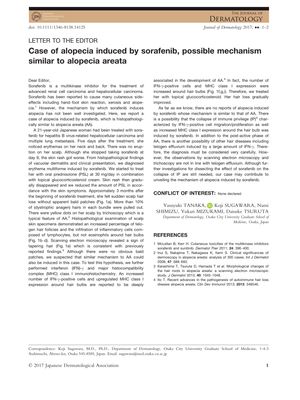Case of Alopecia Induced by Sorafenib, Possible Mechanism Similar to Alopecia Areata
November 2017
in “
The Journal of Dermatology
”
alopecia sorafenib multikinase inhibitor telogen hair follicles lymphocytic infiltration alopecia areata trichoscopy yellow dots scanning electron microscopy tapering hair immunohistochemistry interferon-gamma major histocompatibility complex class I immune privilege glucocorticosteroid hair loss AA IFN-γ MHC class I topical steroids

TLDR Sorafenib may cause hair loss in a way similar to alopecia areata.
In 2017, a case was reported of a 21-year-old Japanese woman who developed alopecia after being treated with sorafenib, a multikinase inhibitor used for advanced renal cell carcinoma and hepatocellular carcinoma. The patient experienced hair loss without apparent bald patches, and histopathological examination revealed an increased percentage of telogen hair follicles and lymphocytic infiltration around hair bulbs, similar to alopecia areata (AA). Trichoscopy showed yellow dots on the scalp, a typical feature of AA. Scanning electron microscopy indicated tapering hair, consistent with AA. Immunohistochemistry showed increased interferon (IFN)-γ-positive cells and major histocompatibility complex (MHC) class I expression around hair bulbs, suggesting a collapse of immune privilege, which is associated with AA. The patient's hair loss improved with topical glucocorticosteroid treatment. This case suggested that sorafenib might induce alopecia through a mechanism similar to AA, although further research was needed to understand the effect of sorafenib on immune privilege collapse.



